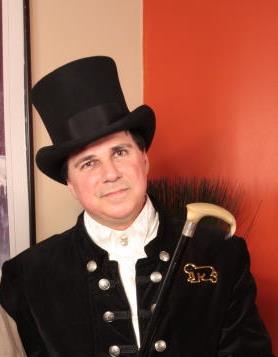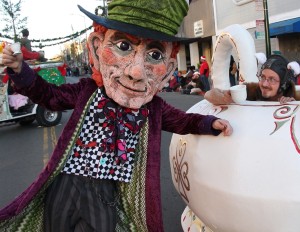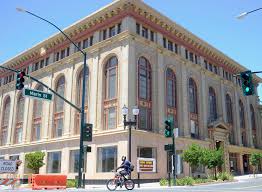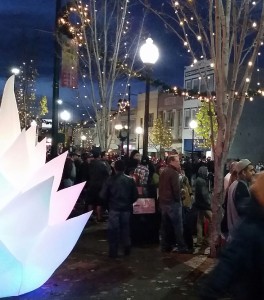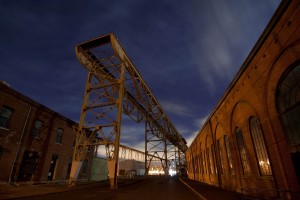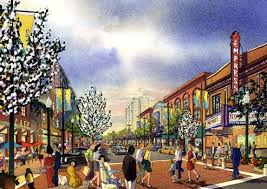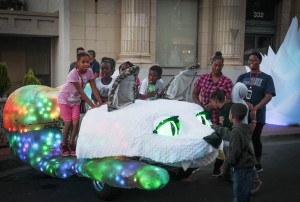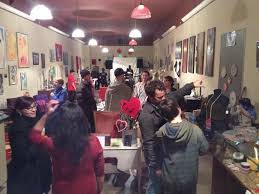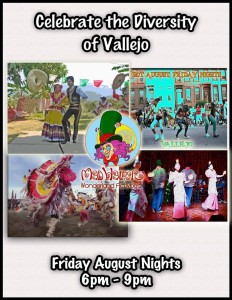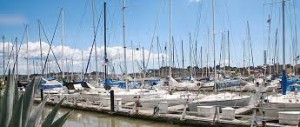There’s a popular Mad Hatter Holiday Festival that attracts thousands of people bringing in the holidays for the city of Vallejo, California.
It’s the Waterfront Weekend Festival in the Fall, an Italian-themed Renaissance festival and multiple events in the planning stages, a Saturday Farmer’s Market, besides a number of successful waterfront and City Park festivals that have been going on way beyond their tenth-year celebration.
The housing crisis is settling down and people are moving to more affordable homes in Vallejo because of the Bay Area’s overpricing. The new residents are in the process of fixing their homes and settling in thereafter may use possible disposable income to support entertainment and the arts.
Vallejo had an influx of newcomers attracted by affordable homes. The opening of Temple Arts Loft, made available studios to low-income persons and artists as a place to create, which brought a burst of creative energy and new blood to the downtown district.
The artists opened their studios along Marin and Georgia Streets with art showings and exhibits, then started art walks, wine walks, and art displays that filled the windows of vacant buildings.
Now the big question – When is it going to happen downtown and on the beautiful waterfront?
We heard about the potential and all the pieces that are there, so when?
Vallejo was once home to over a dozen waterfront and downtown festivals every year with enough people to support the many businesses in the downtown district. Then the Navy packed-up and left in 1996. That was 18 years ago. Buffalo and Portland, both went through a thirty-year revitalization process that brought them to where they are today. Is Vallejo 12 years away in the process? Let’s see.
The city has invested millions in infrastructure in the downtown and waterfront (a sign of the thirty-year plan for revitalization common in multiple cities): a new parking garage structure, remodeling of the Vallejo Ferry Terminal Building and the JFK Library; newly paved tree-lined roadways and sidewalk payment on the waterfront and in downtown – millions of dollars has gone into the opening of The Empress Theatre and the rehabilitation project of the Masonic Building into the Temple Art Lofts (artist residents and affordable housing)and more planning is underway for millions more to be invested in the downtown besides a ferry link to Mare Island with the addition of a pavilion.
In the downtown district there are a number of art galleries and studios that opened as well as a first boutique shop, a bookstore and coffee house in the downtown; a short walk away on the waterfront, there is a coffee house, several restaurants and a beer tap room. Trees that line the downtown streets have been aglow at night with lights; there are security cameras, and roving security personnel – as well as police presence on bicycles at times – then why isn’t it happening for the downtown and waterfront.
Other cities’ downtowns are in their infant stages but on their way to recovery, and outpacing Vallejo’s downtown, as Cape May, N.J. a historic seaside, that has seen its once-faded grande dame hotels and low-slung motels get stylish makeovers. Those makeovers attracted affluent visitors; since its new generation of proprietors brought tastefully appointed boutiques, organic-food shops and laid-back restaurants to the seaside town.
Our northern neighbor Livermore that was once a dead zone on its First Street had only two theaters: the Bankhead Theater and the Livermore Cinema that brought people for shows, but the surrounding retail space was plagued by vacancies. Then the sizzle started when the restaurant Sauce opened after three failed restaurants – this Southern-themed barbecue joint was packed from the start with a lively atmosphere and had rocking country bands, its success led the way for other establishments to follow providing more eateries.
The Vine Theater that opened in 2007 repurposed itself with a different strategy by 2009 by remodeling the theater into an independent movie house to accommodate a dozen or so tables, plus comfy sofas in the front; serving beer and wine, including local Livermore Valley craft breweries, and food from another new restaurant Zephyr. The Vine tripled their business, creatively catering to people’s wishes hosting art films, independent films, spiriting events, classic movie series and popular older films, and sing-along film participation – this business changed to survive that the community has embraced.
Vallejo has one of its anchor institutions downtown: The Vallejo Naval & Historical Museum, does it draw the community and tourists with the many programs and exhibitions offered. Funding a Museum to keep its doors open is the challenge: The American Association of Museums collected data on financial support for museums and outlined four crucial sources of funding: investment income, government (federal, state, and local), private donations (largest share 38%), and earned revenue (admission fees, rentals, gift shop sales, bookstores, and restaurants) stores and restaurants has become a trend with many museums to upgrade those offerings to become a destination for the community and tourists. Will the museum survive and prosper in Vallejo – should it reconsider its position in the community as a cultural source for the ethnically diverse population. Or can it promote its museum store with a location in the Ferry Building, a likely location for the many thousands of Ferry riders daily, it would be a great generator of sales and exposure for the museum that could increase membership and support since funding from government has declined as well as private donations.
On a smaller scale, but successful, is the Sonoma Valley Museum of Art that exhibits works by regional, national and international modern and contemporary artists; engages the community and has staged more than 70 exhibitions attracting more than 130,000 visitors and a membership base of more than 1,000 supporters.
Then what of a cultural center representing the diverse ethnic population of Vallejo, will that work: In Pittsburgh a 42 million dollar investment was made on the accomplishments of the renowned 20th century Pulitzer Prize winning playwright August Wilson, who grew up in the Hill District of Pittsburgh.
Creating a center was an effort to celebrate a city and the working class people: August Wilson Center for African American Culture was opened in 2009 and went bankrupt in 2014. Mark Clayton Southers, a former director of its theater program said the Wilson Center struggled to find an audience among the people Wilson portrayed: working class blacks. “You can’t build it and they will come, “Mr. Southers said, “Not when you’re trying to work with a community that is not traditional theater goers or cultural consumers.” The cultural center’s theater now rents to a largely white mega church.
Closer to home Copia: The American Center for Wine, Food and the Arts was built to cater to those who celebrate and share the pleasures and benefits of wine and its significance to culture in Napa Valley has shut its doors – a $50 million dollar investment. It projected 300,000 visitors a year and fell too short. Yet, Oxbow Public Market, next door to Copia, filled with food and wine from Napa Farmers and hosting local night events attract tourists and locals with over one million visitors a year.
When the U.S. Navy left Mare Island the economic base was weakened and disorganization and social unrest followed. Competition became keener within the downtown community, and the weaker elements were either forced into a lower economic level or were compelled to withdraw from the community entirely. The settler type of population, the married couples with children, usually withdraw from the center of the city while the more mobile and less responsible adults herd together in the apartment regions near the heart of the community. This process of population-sifting produces different cultural areas representing different mores, attitudes, and degrees of civic interest.
It is in the Seattle neighborhoods, especially those on the hill-tops that the conservative, law-abiding, civic minded population elements dwell. The downtown section and the valleys, which are usually industrial sites, are populated by a class of people who are not only more mobile but whose mores and attitudes, as tested by voting habits, are more vagrant and radical.
Seattle had its challenges: when car dealers vacated the old Auto Row for the suburbs, those showrooms once housed in beautifully constructed buildings created during the post-World War II era of grand buildings, sat empty – the area then attracted artists and musicians because of the low rents in the 90s which spawned bars and music venues. In the last decade, preservation-minded developers transformed many of those automotive buildings into offices, apartments, and shops, restoring original windows, old-growth beams and wood floors. Today it is the epicenter of the popular Capitol Hill neighborhood, claiming some of the best restaurants, nightclubs and vinyl record stores in the city.
The success took preservation-minded developers to get involved. Can the Vallejo downtown landlords afford to offer low-rents for business to have time to prosper, if not, it may hurt new arrivals – unless the landlords see the value of getting more start-ups happening to attract people downtown on a recurring basis. These undercapitalized start-ups need to provide a business plan that would convince landlords and banks to assist in supporting their venture, but it must have a sustainable outcome in the plan to achieve. The success of any start-ups would attract entrepreneurs with investment capital.
Americans are known the world over for their emphasis on practicality. “Will it work?” “Is it practical?” such insistent questioning of a new idea or policy or gadet illustrates this emphasis, which at the same time is reflected in the prestige held by the engineer, the physician, and the businessman, as opposed to the schoolteacher, the clergyman, and the philosopher. Who are leading those questions downtown on practicality or strategic planning?
Harvard Business School Professor John Kotter, who studies the dynamics of change, notes that people who succeed in improving things at a corporation, organization or community, “look for avenues that will produce some short-term wins, some visible changes that are associated with their effort, within six or 12 months. This gives them credibility and discourages the cynics…change of any magnitude tends to take time, so short-term wins are essential, and must be an integral part of the long term strategy – being that there is one.
Then there is Mare Island with great significant history – but not much in visitation from the general public. Interesting that in New York City, Governors Island had few visitors as well until recently with the free ferry that has taken 250,000 people to the island so far during the summer season, they have kayaks and bicycles that are for rent to use to circumnavigate the island; Big Apple Circus trapeze lessons, a free Pulse Ensemble Theater production of Shakespeare, sculpture dotting the grounds, a Civil War re-enactment, and a popular miniature-golf course designed by an arts group, it has become a breezy playground for the arts.
Governors Island was originally a military base of strategic importance at the heart of New York Harbor. In 1997, it was shuttered by the federal government and it took years for it to find its footing –nearly all the objects and events have a populist slant; aesthetic democracy is the crux of the island’s culture – there are many partnerships and participating groups with long-term contracts to attract a broad array of people and there is no amphitheater or concert hall or chamber ensembles; the experience of culture began with festivals.
Many are hoping entrepreneurs will take on the risk of opening hot spots downtown – though entrepreneurs are not exactly risk takers, more like ‘calculating’ risk takers – the word that can be the difference between failure and success is something that Leonard C. Green tells his students at Babson College, which has been the number one school for teaching entrepreneurship for as long as they have been doing the rankings.
They figure out a way to reduce risk with every step they take. They follow Act. Learn. Build. Repeat model – they are not risk takers but actually risk adverse. Take small steps towards their goals, and minimize the small investment – ask questions – how can I take this step more cheaply, how to do it better (are those questions being asked on projects going forward – answer those questions and know that the answer will lead to sustainability) Risk takers are NOT successful, as a rule. They leave too much to chance.
For entrepreneurs to invest in a rebuilding of a downtown there must be a show of pedestrians daily, one way to achieve that is to bring people by involving them in projects with as many groups in the community as possible: senior bike rides or walks, daytime children programs, historic walking tours, daytime shopping or dining specials – there needs to be an active outreach in getting to know who the major stakeholders are that can assist in attracting people. How many community groups are currently involved in the downtown activities – maybe one or two, possibly three.
The suburbs are the small town’s last stand – they represent the last great hope for preserving small-town values within the ever changing metropolitan orbits. In the Open Streets project in Waterloo, ON, Canada that provides family friendly programming and economic benefits to their uptown area for three afternoons and one evening more than 100 community groups and businesses are involved in taking over the street with events such as a petting zoo, music, chalk art, food and drink, and sidewalk sales.
Unique holiday traditions can be an attraction as it builds momentum: The holiday tradition in McAdenville, N.C. lights up as Christmas Town U.S.A with a nighttime procession down Main Street, the event started in 1950 where children in McAdenville come together to drag a Yule log through town, passing shops and houses aglow in green, red and white holiday lights. Cheered by townspeople and visitors, the children end their four-block trek at Legacy Park, where the log is burned in an outdoor fire pit, followed by a community celebration featuring hot chocolate, popcorn, the singing of Christmas carols, and a visit by Santa Clause. The event is filled with traditions, symbolism and good-natured superstitions: Pulling the sled brings good luck all year. Today, the glow of Christmas Town makes McAdenville an annual destination and it has grown to a month-long celebration with light displays involving residents, businesses, and churches that annually draws a half-million visitors who slowly drive the 1.3 mile loop through town.
Sonoma and Napa Valley gave a lot of thought to enhance their economic situation through expansion into nontraditional farm-related activities that incorporates tourist activities that couple farm operations with a distinct regional identity or culture: with farm tours and hands on farming; Vermont Fresh Network, a consortium of farmers, restaurants and small food stores work together to create local markets for farm commodities – call it agro-tourist activities. Working together is the idea with what the city has to offer for economic development and to attract tourists.
Where are we in Vallejo towards this revitalization process – In Walker’s Point, Milwaukee over the past two years, small start-ups have re-energized this working-class neighborhood south of the Milwaukee River: public Radio Milwaukee, Stone Creek Coffee, artisanal food, besides the smattering of antiques shops for between-bite browsing, there is a creamery of cheeses and Purple Door Ice Cream, with a unique blend of flavors, a Milwaukee Brewing Company, Indulgence Chocolatiers, and Braise Restaurant where the ingredients that are used for the menu are sourced from regional farms.
Asheville, N.C. that once was full of pawn shops, tattoo parlors and auto repair shops had affordable rentals that attracted many younger people, though it has become a blue-collar hybrid with yoga studios and bistros joining longtime establishments and new to the scene is an eclectic venue “The Odditorium” part Ripley’s and part multigenre performance space, an Oyster House Brewing Company , a record shop, a popular brunch business “Biscuit Head” with farm fresh ingredients – they seem to be on their way to a revitalization with such a mix of character.
Use of cultural activities and facilities bolster a city’s image, attract tourism, and foster economic development has become widespread not only in traditional cultural capitals of the world such as New York or Paris, but also in places not as well-known for their cultural status, such as Newark, New Jersey.
Cultural development strategies have acquired significance in the economic development plans of cities, cultural activities are considered as urban tourist draws and a significant factor in how individuals choose where to live and work. Cultivating clusters of smaller-scale music and performing arts organizations and commercial enterprises – proponents point to cities such as Austin, Texas and Portland, Oregon that have concentrated on the provision of cultural amenities without the large, high profile flagship destinations, and neighborhoods in larger cities such as SoHo in New York and South of Market (SoMA) in San Francisco as models to emulate.
Vallejo also tops the nation in ethnic diversity and revolves around its cultural diversity yet at the same time doesn’t capitalize on its unique flavor. If the historic downtown is to value its cultural diversity through inviting different cultures to participate and headline events and festivals, street closings, and exhibits it would strengthen the bonds of friendship and cultural understanding not only within its city limits but also inviting the surrounding communities to participate in a beautiful mosaic and mix of color and heritage: living, learning, and growing together.
In a survey that was initially piloted in the Los Angeles Department of Cultural Affairs. Seventy-nine percent of the major cities surveyed have organized cultural events over the last ten years. Saint Louis’ Louis and Clark Festival, San Jose’s Gay Pride Parade, Oakland’s Art and Soul Festival, and many ethnic festivals put local heritage and diversity on display. Some cities have music festivals or use events to provide opportunities for the public to experience the local arts: the City of Baltimore sponsors Artscape and Dallas has City Arts, while many of the cities organize music, particularly jazz, festivals – 79% of the respondents indicated that their local government has helped promote cultural activities – yet only 12 cities (41%) have opened a community arts or cultural center in the last ten years such as Los Angeles, Chicago, and Dallas, that provide support for the entire range of cultural activities rather than strategically focusing on the neighborhood level.
Tampa, Florida’s Cultural Affairs is developing an “artist village” of live-work spaces. This is a strategy to revitalize an “historic yet blighted area” and also to benefit local artists. Most cities expressed a preference for flagship cultural facilities and major events. The emphasis on tourism and large, prominent facilities and events, are termed as an entrepreneurial model. Cultural activities are a major draw for new businesses and to attract and retain residents – entrepreneurial motives such as “attracting visitors and tourists” were the top priorities of most cities rather than improving the quality of life with cultural activities thus bringing revenue to a city allows the city to invest more in city services and infrastructure.
What can make Vallejo so distinctive is the success of the many emerging organizations and smaller-scale (sometimes informal) arts and culture activities around town and in outlying neighborhoods”, and that “smaller venues and facilities tend to be more dynamic and take greater risks that challenge the community and encourage dialogue.”
Vallejo has great history to capitalize on the Landmarks Commission produced a walking map for tourist and the community that has been successful and surprising to visitors “When History Speaks” showcasing its architectural wonders and some of our famous residents: Raymond Burr, Boris Karloff, Tug McGraw, and the Duchess of Windsor. The Commission produced one for Mare Island as well. All this is one step at a time, researching, writing, fact finding, laying out the map, designing it, and proof reading all with a small group of volunteers, can take six months or longer for one brochure, to get it right.
This is a city with an astounding strong sporting community, one time attracting thousands to the waterfront for boating races and regattas – activity is beginning to take shape again with waterfront kayaking and biking, along with marathons and triathlons attracting hundreds to the feat, if there is the addition of bicycle riders as well as kite flying coupled with Yoga and Tai Chi Classes happening an active waterfront will be on its way.
All and all it is an outreaching effort to engage the greater community in the City of Vallejo to share the importance of their downtown and waterfront, and to understand and respect its significant history and place in this nation. It is the intergrading and co-mixing of the many nonprofits, chambers, clubs, and businesses to take place in downtown to put local heritage and diversity on display. Then incrementally build-up well-organized and sound activities on the waterfront and downtown that involve these multiple groups that supports their many varied interests. That is what is attractive and inviting and the reason many choose to live and reside in Vallejo.
There is always the question of crime being a determinant for people to frequent the downtown while in its revitalization process, in a study published by the University of California Press, Social Problems(2011), Seattle’s downtown tracts underwent rapid revitalization during the 1990s and that these areas (1) saw reductions in crime relative to similar tracts that did not gentrify, and (2) were areas with higher than average crime at the beginning of the decade; the findings concluded with gentrification in its earlier stages is associated with small increases in crime, but gentrification in its more consolidated form is associated with modest crime declines.
For the process to move forward, more businesses of mix offerings to the general public need to open downtown and for start-ups to explore their talents and skills that many of the successful cities sited have used with their addition of coffee shops, organic ice-cream stores, cheese shops and unique boutique shops.
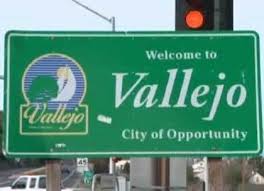 Not one flavor but many, not one idea but one that is carried out to fruition, it is not opening a shop, it is having a business plan that would lead the business to sustainability, it is investing and targeting the people who will support the downtown on a consistent basis, it is changing the perception of the greater community that things are happening for the better and inviting our outer neighborhood residents in to witness. Then Vallejo will get to that thirty-year mark that Portland and Buffalo claim it took them and many of the successful cities to turn around into a vibrant city.
Not one flavor but many, not one idea but one that is carried out to fruition, it is not opening a shop, it is having a business plan that would lead the business to sustainability, it is investing and targeting the people who will support the downtown on a consistent basis, it is changing the perception of the greater community that things are happening for the better and inviting our outer neighborhood residents in to witness. Then Vallejo will get to that thirty-year mark that Portland and Buffalo claim it took them and many of the successful cities to turn around into a vibrant city.
About the Author
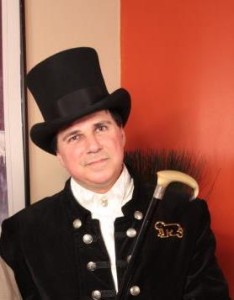 Frank Malifrando (pictured here in Mad Hatter regalia) is CEO of Hyperion Community Partners LLC. He is also an economic development consultant for cultural activities for the City of Vallejo‘s waterfront and historic downtown. Frank develops “Quality of Life” activities for the community from wine tastings, music events, sporting activities and producing the city’s annual signature holiday event that attracts thousands of attendees: “Mad Hatter Holiday Festival, Parade, and Tree Lighting”, which received Special Congressional Recognition defining Vallejo as a place of how art, community and tourism can come together in a very unique way.
Frank Malifrando (pictured here in Mad Hatter regalia) is CEO of Hyperion Community Partners LLC. He is also an economic development consultant for cultural activities for the City of Vallejo‘s waterfront and historic downtown. Frank develops “Quality of Life” activities for the community from wine tastings, music events, sporting activities and producing the city’s annual signature holiday event that attracts thousands of attendees: “Mad Hatter Holiday Festival, Parade, and Tree Lighting”, which received Special Congressional Recognition defining Vallejo as a place of how art, community and tourism can come together in a very unique way.

